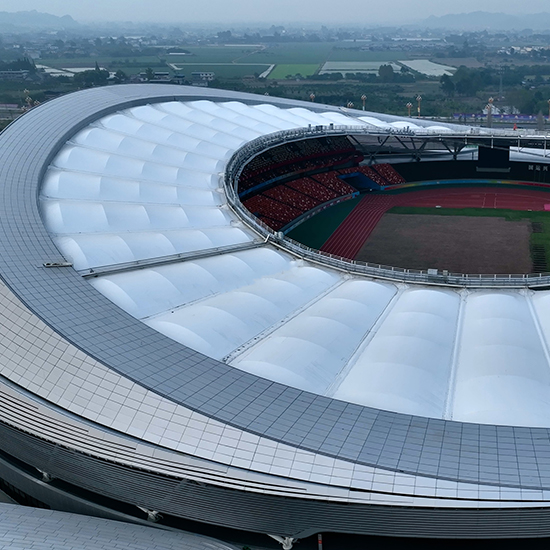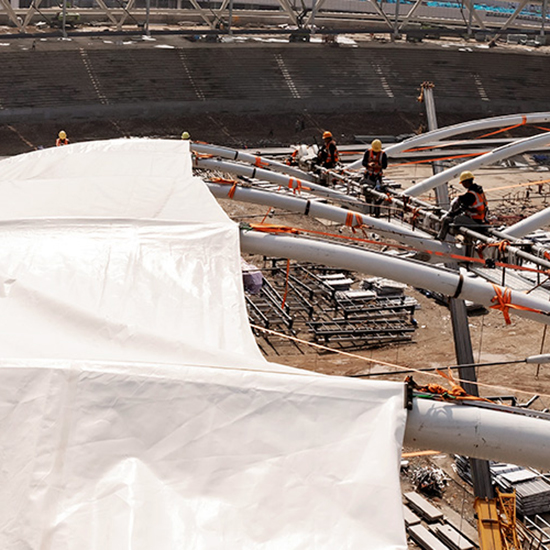ENCN
Home / Glass fiber and architectural tensile membrane structural materials
Glass fiber and architectural tensile membrane structural materials
The U.S. Pavilion and the Fuji Pavilion at the 1970 Osaka Universal Exposition in Japan both used tensile membrane structure building materials, which caused a lot of sensation in the construction industry. In the following decades, the membrane structure of the building was developed rapidly. Most of the membrane structure is composed of steel and cable membrane structure, and the membrane combined with the structure is gradually becoming functionalized and intelligent. The membrane structure material has light and free shape and beautiful appearance; Light transmission, energy saving, environmental protection, excellent flame retardant performance; Anti-fouling and self-cleaning performance; Safety, long life and other advantages. Based on these advantages, the building membrane stands out, and the membrane structure is called “21st century architecture”, which is used in large stadiums, entrance corridors, shopping malls, casinos, parking lots, exhibition venues, plant sightseeing gardens and other buildings.
At present, the widely recognized standards for building membranes are A, B and C stipulated by JISA-93 in Japan, which are divided according to their fire performance. Class A is the best, made of glass fiber fabric as the substrate coated with PTFE; Class B is second, which is coated with glass fiber fabric as the substrate of PVC; Class C is the most inferior of the three, and is made of polyester (polyester) fabric coated with PVC as the base material. According to the coating material, there are polytetrafluoroethylene (PTFE), polyvinylidene fluoride (PVDF), polyvinylidene fluoride (PVF), polyvinyl chloride (PVC), polyurethane (PU), rubber, etc.
PTFE building membrane. PTFE film is a material coated with polytetrafluoroethylene resin on ultrafine glass fiber fabrics. This kind of film has good welding performance, excellent ultraviolet resistance, anti-aging performance and flame retardant performance. In addition, its antifouling self-cleaning is the best of all building membranes, but its flexibility is poor, construction is difficult, and the cost is very amazing. Under the leadership of Geiger, DuPont, Corning Fiberglass, Baird Construction, and Chemical Fiber Weaving jointly developed permanent membranes. The processing method is to quickly put the glass fiber fabric into the Teflon melt for many times, so that there is a uniform Teflon coating on both sides of the fabric, so that the permanent PTFE film is officially born. Since then, permanent membrane structures have officially become popular in the United States, and many scholars have conducted in-depth research on membrane structures. After 20 years, the follow-up test results show that the mechanical properties and chemical stability indicators of this film have only decreased by 20%~30%, the color has almost changed, the surface of the film is smooth, elastic, the dust and chemical particles in the atmosphere are extremely difficult to attach and penetrate, and the building film can restore its original clean surface and light transmittance after rain washing, which is enough to show the strong vitality and broad market prospects of PTFE film.
At present, the development and application of this membrane material abroad is relatively mature, and there are many manufacturers, such as German Mehler company, Verseidag company, Japan Taiyoko-gyo company, ZTE Chemical Industry Co., Ltd., American Chemfab company, Saudi Arabian Obei Kan company, etc. Domestic Ningbo Tianta Polyfluoride Glass Fiber Co., Ltd. and Taizhou Weiwei Polymer Co., Ltd. and so on.
Glass fiber PVC building film. This kind of film material was developed and applied relatively early, usually stipulating that the thickness of PVC coating on the intersection of glass fiber fabric warp and weft lines can not be less than 0.2mm, and the general coating will not be too thick to meet the requirements of use. In order to improve the aging resistance of PVC itself, some light and heat stabilizers are often added to the coating, light-colored transparent products should add a certain amount of ultraviolet absorbent, dark products often add carbon black as a stabilizer. In addition, there are many ways to surface treat PVC, such as laminating a very thin metal film or spraying aluminum mist on PVC, using mica or quartz to prevent the surface from sticking and staining.
Glass fiber silicone resin building film. Silicone resin has excellent high and low temperature resistance, water repellency, oxidation resistance, etc., the film material has high tensile strength and elastic modulus, in addition to good light transmission. The Vestar film developed by Owen Kenin Company in the United States is made of this resin to coating glass fiber cloth, and there are not many applications of this film and fewer manufacturers.
Glass fiber synthetic rubber building film. Synthetic rubber (such as nitrile rubber, neoprene) has good toughness, stable to sunlight, ozone, heat aging, has outstanding wear resistance, chemical resistance and flame retardancy, can reach translucent state, but because it is easy to yellow, it is generally used for dark coatings.
Extruded PTFE building film. The base cloth woven from puffed PTFE fiber is pasted with a fluororesin film on both sides to obtain the puffed PTFE building film. Because its cost is too high, the general construction considers both cost and performance, rarely choose this membrane, and there are not many foreign manufacturers.
ETFE building membrane. Made directly from ETFE (ethylene-tetrafluoroethylene copolymer) raw meal. ETFE not only has excellent impact resistance, electrical properties, thermal stability and chemical resistance, but also high mechanical strength and good processing performance. In recent years, the application of ETFE film can replace other products in many aspects and show strong advantages and market prospects. This film has particularly good light transmission, known as “soft glass”, light weight, only 1% of the same size glass; Good toughness, high tensile strength, not easy to be torn, ductility greater than 400%; Strong weather and chemical resistance, melting temperature up to 200 °C; It can effectively use natural light and save energy; Good acoustic performance. The self-cleaning function makes the surface less prone to staining, and the rain can take away a small amount of dirt, and the cleaning cycle is about 5 years. In addition, ETFE film can be prefabricated into film bubbles off-the-shelf for easy construction and maintenance. ETFE also has shortcomings, such as the external environment is easy to damage the material and cause air leakage, maintenance costs are high, etc., but with the construction of large stadiums, tourist venues, waiting halls, etc., ETFE has highlighted its advantages. At present, there are very few companies that produce this kind of film, only ASAHIGLASS (AGC), Japan Asahi Glass, Germany Kewell and a few other companies can provide ETFE film, the research and development and application of this film material in foreign developed countries is only more than ten years of history.
The newly completed Beijing Olympic venues “Bird’s Nest” and “Water Cube” membrane structures use ETFE membrane, which is currently the largest ETFE membrane structure building in China, and the membrane materials are imported products. “Bird’s Nest” adopts a double-layer membrane structure, the outer layer is made of ETFE to prevent rain, snow and ultraviolet rays, and the inner layer is made of PTFE to achieve the purpose of heat preservation, anti-condensation, sound insulation and light efficiency. “Water Cube” adopts double-layer ETFE inflatable membrane structure, a total of 1437 air pillows, each piece is like a “water bubble”, air pillows can control the amount of inflation, the shading and light transmittance to adjust, effectively use natural light, save energy, and have good thermal insulation, eliminate echo, for athletes and spectators to provide a warm and comfortable environment.
At present, the development of domestic membrane structure is exciting, with the construction of some large stadiums, waiting halls, etc., and the holding of international events such as the 2010 Shanghai World Expo and Guangzhou Asian Games, it has brought opportunities and challenges to the development of tensile membrane structure in China. Especially in terms of membrane materials, China started late, the technical level is low, and most of the membrane materials mainly rely on imports. PTFE, PVC and surface-modified PVC, ETFE and other membranes are the mainstream of the market and are widely used. China has independent intellectual property rights of PTFE film, and the performance basically meets the requirements of similar foreign products. Many companies, scientific research units and universities are conducting research on PVC surface coating materials, such as PVDF, nano-TiO2 surface coating agents, etc. have achieved initial results, and research on surface antifouling and self-cleaning treatment, such as bionic lotus leaf construction of micro-rough surfaces, has also begun to start. While introducing world-class production equipment and process technology, stepping up digestion and absorption and improving innovation, and developing film surface treatment technology suitable for China’s market demand as soon as possible, it is of great significance to enhance the grade and market competitiveness of China’s entire industrial textile products.
Glass fiber and architectural tensile membrane structural materials




